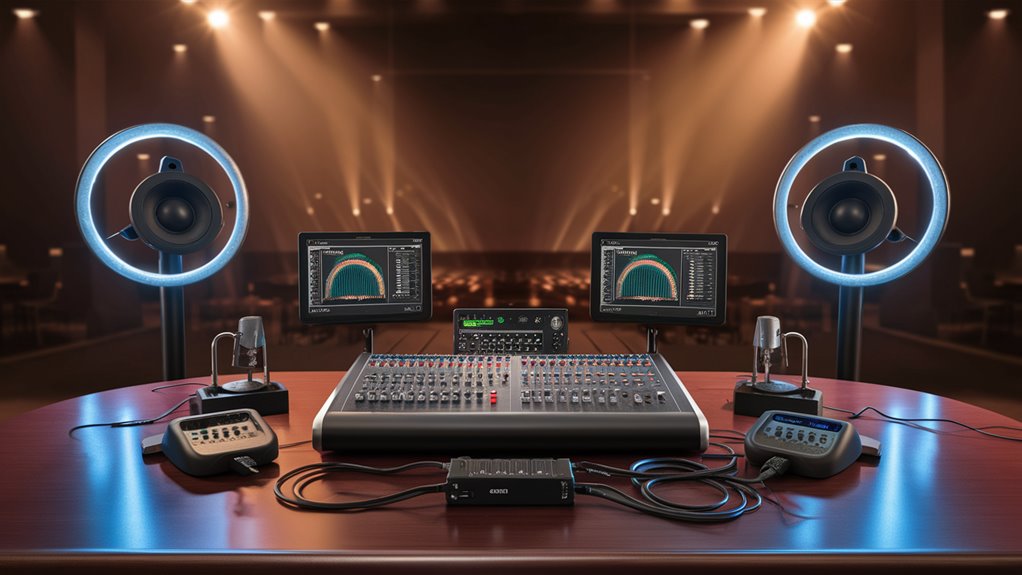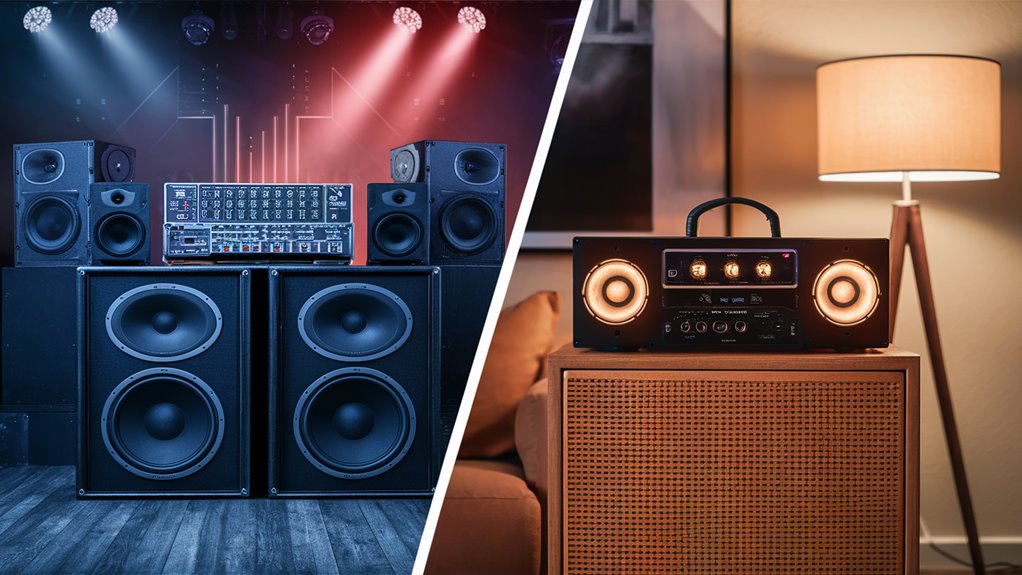
Setting Up Karaoke Sound: Easy Tips

Main Parts for Best Karaoke Sound
To get a great karaoke sound, you need good tools and setup. Start with a 300W RMS setup with two speakers, and 12-inch woofers for deep bass.
Technical Details for Top Results
Choose dynamic cardioid mics that catch clean voices and block bad sounds from 80Hz to 15kHz. Use a 12-channel digital mixer with effects to make voices crisp and the sound great.
Speaker Placement and Room Acoustics
Clever Setup
Place main speakers one-third into the room for even sound. Add panels at first echo spots to stop echo and make sound clear. Keep speakers at least 6 feet from singers to avoid feedback.
Room Size Notes
- Two-way speaker setups: Best for under 1000 square feet
- Three-way speaker setups: Good for bigger areas
- Acoustic panels: Needed to control echo
- Monitor speakers: Important in big spaces
These tips will ensure good sound, clear voices, and top shows in any karaoke setup.
Basic Parts of Karaoke Systems
Main System Elements
A pro karaoke setup needs five main parts: audio source, mixer/amplifier, speakers, mics, and screen.
Basics of Audio Source
Your karaoke audio should handle many file types and split voice and music well. Top systems use special players or high-speed stream tools for great sound and smooth playback.
Professional Mixing and Amplifying
The mixer/amplifier should match impedance well and have extra power. A good setup has a 12-channel digital mixer with effects to balance music and voices.
Speaker System Details
Effective audio needs two main speakers:
- Main PA speakers (at least 300W RMS)
- Monitor wedges for singer feedback
This ensures clear sound output and proper vocal checks.
Specifications for Mics
Top mics should have:
- Dynamic cardioid style
- Optimal vocal range (80Hz-15kHz)
- Built-in noise filters
- Sturdy build for long use
Needs for Visual Setup
The display setup should have:
- At least 32-inch LCD/LED screen
- 1080p resolution
- 5ms response time
- HDMI/VGA connections
- Synced audio-visual output
- Backup power
- Good cable management
Choosing the Right Speakers
Essential Speaker Needs
Choosing the best speakers is key for pro karaoke sound. Three main points affect how they work: sound range, power needs, and how they spread sound.
Mic and Audio Clarity
Choosing Quality Mics for Professional Sound
Dynamic cardioid mics are best for excellent sound work. Models like Shure SM58 and Sennheiser e835 block bad feedback and are very sturdy. These top mics keep sound very clear across their range.
Smart Gain Control
Proper gain setting is key for great sound. Set mic preamp levels to peak at -12dB for extra power in dynamic singing. A high-pass filter at 100Hz reduces low sounds and mic issues.
Professional EQ and Compression
Clear singing needs smart EQ settings. Boosting the 3-5kHz range and cutting 200-500Hz removes muddiness and improves clarity. Professional compression uses a 3:1 ratio, 10ms attack, and 100ms release to balance sound levels and keep sound natural Visit more Website
Using Multiple Mics
Proper phase setup and mic placement are important when many sing. Keep at least 3 feet between singers to reduce overlap. Using feedback stop tools with narrow Q on bad sounds ensures great live sound.
Mixers and Signal Handling

Main Mixer Configuration
Modern mix boards are key in managing pro karaoke sound, offering needed channel options and signal tweaks. A pro-grade mixer should have at least four channels: two for music, one main mic, and one extra. Parametric EQ controls are essential for managing feedback and making voices clear live.
Digital Signal Needs
Digital signal work (DSP) is crucial for pro karaoke systems. Advanced setups need built-in audio effects like reverb and delay for added voice depth. Anti-feedback and dynamic compression are essential for even sound levels and stopping feedback during performances.
Sound Room and Setup
Understanding Room Acoustics
Room sound factors greatly affect how a karaoke system sounds. Important elements like standing waves, flutter echoes, and reverb time deeply impact overall sound quality and what people hear.
Measuring Room and Adjusting
Accurate room measurements help identify sound issues. Clever placement of acoustic solutions at first echo spots, like side walls and roof, improves sound spread. Set up sound-absorbing panels to manage high sounds and bass traps for low sound control in room corners Family Reunion
Clever Speaker Placement
Use the “rule of thirds” for main speaker placement – position them one-third into the room for best sound distribution. Angle speakers towards ear level, considering usual sitting spots. In large spaces, add delayed speakers to maintain even sound all around.
Setting Up Mics
Create a clear singing area with optimal mic placement, staying at least 6 feet from main speakers. This setup reduces feedback issues while ensuring monitors are clear for singers.
Important Gear Placement Tips:
- Set main speakers at 1/3 room width
- Place acoustic panels at first echo spots
- Position bass traps in room corners
- Create a clear singing space far from speakers
- Plan additional speakers for wider coverage
Professional Vs Home Systems
Differences in Main Systems
Pro karaoke systems deliver top performance with high-power amps from 500W to 2000W, balanced XLR connectors, and specialized mix boards with parametric EQ. Built with high-quality components, these systems achieve great signal-to-noise ratios and full sound range from 20Hz-20kHz, ensuring excellent feedback control and dynamic handling.
Details of Home Systems
Home karaoke setups work with less power, from 50W-200W, using unbalanced RCA or 1/4″ connections. These systems use basic graphic EQs and standard digital signal work, making them suitable for home spaces under 500 square feet where sound levels are low.
Technical Work Considerations
Essential Work Points
- Pro Systems:
- THD below 0.1% at full power
- High-quality mic preamp
- Good impedance matching
- Home Systems:
- THD rates up to 1% or more
- Standard preamp components
- Simpler impedance setup
Choosing Needs
The best choice between pro and home systems depends on key factors like:
- Room size
- Max crowd size
- Room sound needs
- Sound quality expectations
- Budget limits
Pro systems perform well in large spaces needing great sound quality, while home systems provide cost-effective solutions for private use.
Budget and ROI Considerations
Initial Cost Breakdown
Pro karaoke equipment requires smart budget planning. A basic home karaoke setup usually costs $500-$1,000, covering essential components like a mixer, two speakers, and a mic system. Commercial space setups need larger investments between $3,000-$10,000, using pro-level equipment like:
- Large amp systems
- Dual-zone performance monitors
- Professional acoustic solutions
- Multi-channel mixing capabilities
Return on Investment Considerations
Commercial venues can see clear returns from several revenue streams. Typical payback periods range from 12-24 months, mainly from:
- Increased drink sales
- Cover charge income
- Longer customer stays
- More repeat visitors
Annual maintenance costs are usually 5-10% of initial investment, covering:
- Speaker maintenance and reconing
- Mic replacements
- System checks
- Software updates
Cost-Efficient Strategies
Smart equipment choices significantly impact long-term financial outcomes. A well-thought-out $5,000 system with proper sound handling often outperforms more expensive setups lacking correct configuration. Key cost-effective strategies include:
- Professional acoustic solutions
- Optimal speaker placement
- Wise component selections
- Room setup adjustments
These steps can reduce initial costs by 20-30% while maintaining professional sound quality standards.